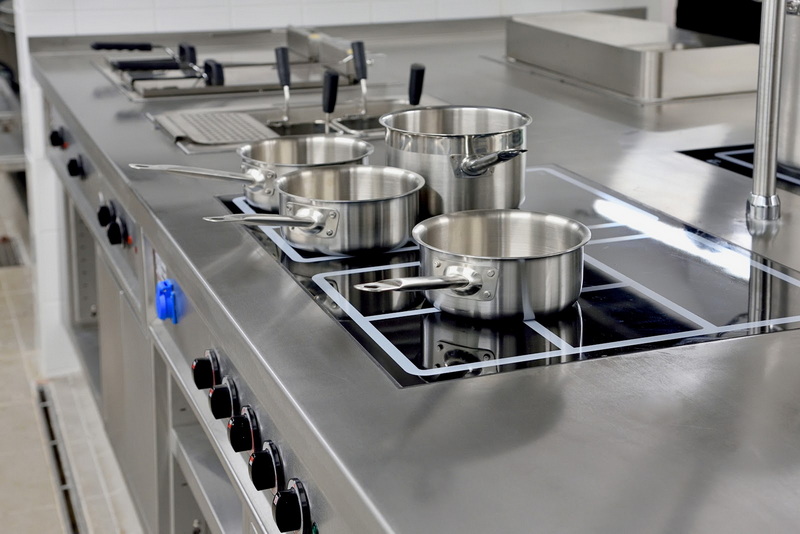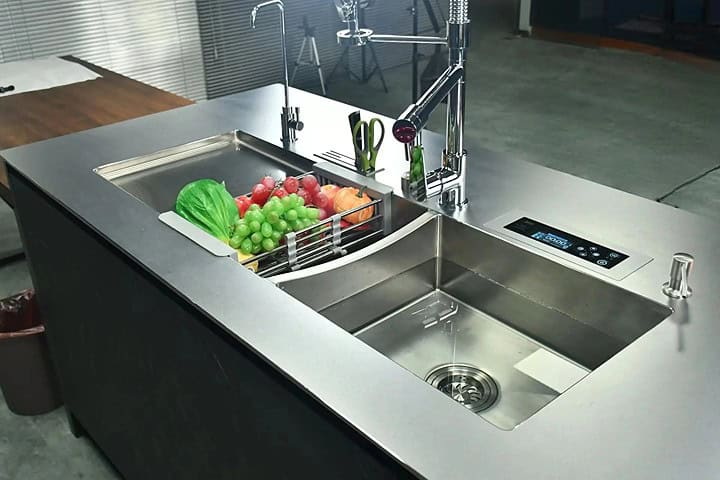English


Views: 222 Author: Tomorrow Publish Time: 2025-07-09 Origin: Site











Content Menu
● Why Stainless Steel is Ideal for Food Industry Applications
● Key Factors to Consider When Choosing Stainless Steel
>> 1. Corrosion Resistance Requirements
>> 4. Surface Finish and Hygiene
● Common Stainless Steel Grades Used in Food Industry
>> Austenitic Stainless Steel (300 Series)
>> Ferritic Stainless Steel (400 Series)
● Applications of Stainless Steel in Food Industry
● Design and Fabrication Considerations
● Advances in Stainless Steel for Food Industry
● FAQ
>> 1. What stainless steel grade is best for food processing equipment?
>> 2. Why is stainless steel preferred over other materials in the food industry?
>> 3. Can stainless steel rust in food industry applications?
>> 4. What surface finish is recommended for stainless steel in food applications?
>> 5. Is ferritic stainless steel suitable for food industry use?
Stainless steel is a fundamental material in the food industry due to its exceptional properties that meet the rigorous demands of food processing, preparation, and storage. Selecting the right stainless steel for food industry applications is crucial for ensuring hygiene, durability, corrosion resistance, and compliance with safety standards. This article explores the key factors to consider when choosing stainless steel for food-related uses, the types of stainless steel commonly employed, and their specific applications.

Stainless steel is widely regarded as the gold standard material in the food industry for several reasons:
- Corrosion Resistance: Stainless steel resists corrosion caused by water, food acids, cleaning chemicals, and other harsh environments, ensuring longevity and safety.
- Chemical Inertness: It does not react with food products, preventing contamination or alteration of taste.
- Ease of Cleaning and Sterilization: Its smooth surface allows for thorough cleaning and sterilization, essential for maintaining hygiene.
- Durability and Strength: Stainless steel withstands mechanical stress, high temperatures, and wear, making it ideal for heavy-duty food processing equipment.
- Recyclability: It is nearly 100% recyclable, supporting sustainability in the food industry.
These attributes make stainless steel suitable for a wide range of food processing equipment, from storage tanks and pipelines to cooking appliances and utensils.
When selecting stainless steel for food industry applications, consider the following factors:
Food processing environments often expose materials to moisture, acids, alkalis, and cleaning agents. The stainless steel grade must offer sufficient corrosion resistance to withstand these conditions without degrading or contaminating the food. For example, acidic foods like citrus or tomato products can accelerate corrosion on less resistant grades. Similarly, exposure to salty or chloride-rich environments, such as seafood processing, demands materials with enhanced resistance to pitting and crevice corrosion.
Depending on the application, stainless steel must have the appropriate strength, toughness, and formability. For example, equipment subjected to mechanical stress or impact requires steel with high tensile strength and fatigue resistance. Some food processing components, such as conveyor belts or cutting equipment, also require stainless steel that can be easily fabricated or formed into complex shapes without cracking.
Some food processing operations involve high temperatures, such as cooking, pasteurization, or sterilization. The stainless steel chosen should maintain its properties and resist oxidation at elevated temperatures. Grades like 304 and 316 perform well under typical cooking temperatures, but for continuous high-heat exposure, specialized grades with enhanced heat resistance may be necessary.
A smooth, non-porous surface finish is essential to prevent bacterial growth and facilitate cleaning. Polished or passivated finishes are preferred in food contact surfaces. Rough or scratched surfaces can harbor bacteria and food residues, increasing contamination risks. Therefore, surface roughness should be minimized, and regular maintenance should ensure the finish remains intact.
Balancing performance with cost is important. Some stainless steel grades offer excellent properties but at a higher price, while others provide adequate performance for less demanding applications at a lower cost. The choice often depends on the specific food product, processing environment, and budget constraints.
The stainless steel grades used in food applications mainly belong to the 300 and 400 series, each with distinct characteristics.
| Grade | Composition Highlights | Properties | Typical Food Industry Applications |
|---|---|---|---|
| 304 | 18% Chromium, 8% Nickel | Excellent corrosion resistance, non-magnetic, good formability | Processing equipment, storage tanks, kitchen utensils, dishwashers |
| 316 | 16% Chromium, 10% Nickel, 2% Molybdenum | Superior corrosion resistance, especially against chlorides | Dairy, beer brewing, seafood processing, high-salt environments |
| 430 | 17% Chromium, no Nickel | Magnetic, good corrosion resistance in mild environments, cost-effective | Kitchen appliances, cookware, food storage where corrosion is less severe |
Austenitic grades like 304 and 316 are the most commonly used in food processing due to their excellent corrosion resistance and ease of cleaning. Grade 316 includes molybdenum, enhancing resistance to pitting and crevice corrosion, making it suitable for more aggressive environments such as those involving saltwater or acidic foods. Austenitic stainless steels are also non-magnetic, which can be an advantage in certain applications where magnetic interference must be avoided.
Ferritic grades such as 430 are magnetic and less expensive but offer lower corrosion resistance than austenitic steels. They are used in applications where exposure to corrosive agents is limited, such as in kitchen appliances or food storage containers that do not come into direct contact with highly acidic or salty foods. Their lower nickel content makes them a more economical choice, though they are less ductile and harder to weld.

Stainless steel is employed in numerous food industry components and equipment, including:
- Processing and Storage Tanks: For beverages, dairy, and food products, stainless steel tanks ensure hygienic storage and prevent contamination. These tanks often require seamless construction and polished interiors to facilitate cleaning.
- Pipelines and Tubing: Transport of liquids and semi-liquids requires corrosion-resistant and cleanable piping. Stainless steel tubing is preferred due to its smooth interior surfaces that reduce friction and bacterial buildup.
- Cooking Equipment: Ovens, grills, burners, and conveyors benefit from stainless steel's heat resistance and durability. These applications often require stainless steel that can withstand thermal cycling without warping or degrading.
- Food Preparation Surfaces: Counters, tables, and shelving made from stainless steel provide sanitary work areas. Their resistance to stains and ease of cleaning help maintain food safety standards.
- Utensils and Containers: Pots, pans, trays, and molds are often stainless steel for safety and ease of cleaning. These items must be food-grade and free from coatings that could chip or degrade.
- Refrigeration and Dishwashing Equipment: Stainless steel housings and interiors resist moisture and chemical exposure, ensuring longevity and hygiene in appliances.
Selecting the right stainless steel grade is only part of the equation. Proper design and fabrication techniques are essential to maximize the benefits of stainless steel in food applications:
- Surface Finish: Polished or passivated surfaces reduce bacterial adhesion and facilitate cleaning. Passivation involves treating the stainless steel surface with an acid solution to remove free iron and enhance the chromium oxide layer, improving corrosion resistance.
- Welding and Joining: Correct welding methods prevent corrosion at joints and maintain material integrity. Techniques such as TIG (Tungsten Inert Gas) welding are preferred for food-grade stainless steel to ensure clean, strong welds without contamination.
- Cleaning in Place (CIP): Equipment should be designed to allow cleaning without disassembly, improving hygiene and efficiency. CIP systems use automated cleaning cycles with detergents and sanitizers to maintain equipment cleanliness.
- Avoiding Crevices: Design should minimize crevices and dead spaces where food residue can accumulate. Smooth transitions and rounded corners help prevent bacterial growth and facilitate cleaning.
To ensure longevity and hygiene, stainless steel equipment should be regularly cleaned with appropriate agents that do not damage the surface or cause corrosion. Avoid using abrasive materials or chloride-containing cleaners that can cause pitting. Routine inspections to identify scratches, dents, or corrosion spots allow timely repairs and prevent contamination. Proper drying after cleaning also helps prevent water spots and corrosion.
Recent developments in stainless steel technology have introduced specialized alloys and surface treatments tailored to food industry needs. For example, duplex stainless steels combine austenitic and ferritic properties, offering higher strength and improved corrosion resistance. Additionally, antimicrobial stainless steel surfaces incorporating copper or silver ions are being explored to reduce microbial contamination further.
Choosing the right stainless steel for food industry applications requires a careful assessment of the environment, mechanical and chemical demands, and hygiene requirements. Austenitic stainless steels such as grades 304 and 316 are generally preferred for their superior corrosion resistance and cleanability, while ferritic grades like 430 offer cost-effective options for less demanding uses. Proper design, fabrication, and maintenance complement the inherent advantages of stainless steel, ensuring safe, durable, and efficient food processing operations. Advances in stainless steel alloys and surface technologies continue to enhance the material's performance, supporting innovation and safety in the food industry.

Grade 304 stainless steel is widely used due to its excellent corrosion resistance and ease of cleaning. For more corrosive environments, grade 316 is preferred because of its added molybdenum content.
Stainless steel is corrosion-resistant, non-reactive with food, easy to clean, durable, and recyclable, making it ideal for maintaining hygiene and safety in food processing.
While stainless steel is highly resistant to rust, improper maintenance, exposure to chlorides, or damage to protective layers can lead to localized corrosion. Using the correct grade and proper care prevents rust.
Smooth, polished, or passivated finishes are recommended to minimize bacterial adhesion and facilitate cleaning, ensuring hygienic conditions.
Ferritic stainless steel like grade 430 is suitable for applications with low corrosion risk and where magnetic properties are acceptable. For more demanding environments, austenitic grades are preferred.
Stainless Steel Grades 201 Vs 304: Cost Vs Performance Breakdown
316L Vs 316 Stainless Steel Grades: Which Is Better for Corrosion Resistance?
Comparing Austenitic Vs Martensitic Stainless Steel Grades: What You Need To Know?
Stainless Steel 430 Vs 304: Key Differences Explained for Manufacturers
304 Vs 316 Stainless Steel Grades: Which One Suits Your Project Best?
Stainless Steel Pipes Vs Galvanized Pipes: Durability And Cost Analysis
Comparing Stainless Steel Pipes And PVC Pipes: What You Need To Know?
Stainless Steel Pipes Vs Copper Pipes: Pros And Cons for Industrial Use
Seamless Stainless Steel Pipes Vs Welded Pipes: Key Differences Explained
Stainless Steel Pipes Vs Carbon Steel Pipes: Which One Suits Your Project?
